Star Trek: Voyager has a morbid fascination with the Borg. Quite literally.
Time and time again, the series returns to the image of the Borg dead and dying. Blood Fever ends with the discovery of a Borg corpse. Unity features the extended autopsy of that corpse. In Scorpion, Part I, Kes is haunted by the image of a grotesque mound of Borg drones, torn apart and reassembled. In Unimatrix Zero, Part I, the Borg Queen tears the heads off her drones and mounts them on spikes. There is a very similar image in Dark Frontier, Part I, where Janeway wanders casually through the wreckage of a Borg ship.

Queen of minds.
Star Trek: The Next Generation worked hard to establish the Borg as a credible threat. If the Borg were associated with death, it was only because they delivered something akin to it. In The Neutral Zone, the Borg scooped an entire outpost off the surface of a planet. In Q Who?, Picard had to literally beg Q to save the Enterprise after the loss of eighteen crewmembers. In The Best of Both Worlds, Part I and The Best of Both Worlds, Part II, the Borg tore through the Federation like it was made of tissue paper. The trauma of that invasion informed Emissary.
In contrast, Voyager seems preoccupied with the destruction and desecration of the Borg Collective. This is an interesting creative choice on a number of levels. Most obviously, it severely undercuts the menace and threat posed by the Borg Collective. Janeway seems to travel through the Delta Quadrant leaving a trail of broken Borg bodies in her wake. It is hard to believe that the Borg are a big deal, when Janeway seems to decorate her ship with their remains. The Kazon, the Vidians and the Hirogen have all taken Voyager at some point. The Borg have never.

Green light for reassimilation.
Perhaps this fascination with Borg corpses and remains simply speaks to their visual aesthetic. With their pale skin and their lack of individual identity, the Borg have always evoked the walking dead; Star Trek: First Contact was essentially a zombie movie in deep space. However, perhaps this desecration of the Borg speaks to something buried deeper within the psyche of Voyager. The Borg are perhaps the most iconic aliens of the Berman era; they represent the moment that The Next Generation came into its own. Perhaps their decay mirrors that of the Berman era itself.
Dark Frontier, Part I and Dark Frontier, Part II represent something of a final frontier for the Borg Collective. While the Borg had been in decline for some time, Dark Frontier, Part I and Dark Frontier, Part II marked a point of no return. Regeneration is an underrated return to form for the iconic cyborgs, but it is too little and too late. Dark Frontier, Part I and Dark Frontier, Part II is effectively a funeral for the most iconic adversaries of the Berman era. However, they would remain shuffling lifeless for another two-and-a-half seasons.

Subject to change.
What makes the Borg so effective? After all, the Borg were not the first attempt by The Next Generation to create a credible recurring foe for the crew. The Ferengi had been teased in Encounter at Farpoint and properly introduced in The Last Outpost, landing with a deadening thud. The Ferengi would become awkward comic relief for episodes like The Price or Ménage à Troi, while the Borg would anchor the most successful two-parter of the run and the most successful Next Generation movie.
One of the great absurdities of the larger Star Trek franchise is the way in which the arcs of the Borg and the Ferengi invert one another. The Borg were introduced as an iconic adversary, only to become less threatening and less interesting as the years went by. In contrast, Star Trek: Deep Space Nine managed to successfully reinvent the Ferengi as a multifaceted and compelling alien species. While Profit and Lace or The Emperor’s New Cloak are nobody’s favourite episodes, House of Quark, Family Business and The Magnificent Ferengi are legitimately great.
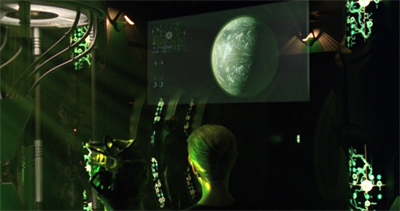
There were no more worlds to conquer…
The reason for this divergence is quite simple. Ira Steven Behr understood the Ferengi as a core concept, while Brannon Braga struggled to grasp the core appeal of the Borg. It can be hard to figure out what exactly the Borg represent. Are they an embodiment of communism, the stripping of a person’s individuality to integrate them into an all-powerful collective? Do they represent the logical endpoint of all-consuming capitalism, where the human body is ultimately just a body and entire worlds exist for the soul purpose of being devoured?
It doesn’t really matter which reading of the Borg applies, much like it doesn’t really matter that Star Trek never quite figures out how exactly the Federation economy is supposed to work. The Borg resonate on a more primal level. They represent the destruction of the individual by a force beyond any one person’s reckoning, the fear that a person might be broken down and transformed into a microscopic cog in a vast machine. In that context, the purpose or goal of the machine is a secondary concern, all that matters is the brutal and horrific dehumanisation.

“Get to bed, it’s (assimi)late.”
Jessica R. Johnston argues as much in her introduction to The American Body in Context:
The Borg have the power to technologically discipline all individuals into conformity and compliance. According to the Borg, individual resistance to this bodily incorporation is futile; the concept of freedom is irrelevant. All will be assimilated. This part of the storyline suggests that no matter how strong-willed, the lone individual cannot fight the advances of bioengineering and technological oppression. Conformity to the will and social control of advanced technology is ensured. Even the strong-willed Picard cannot resist working for and with the advanced technology of the Borg.
If Star Trek is built upon the myth of American individualism, the Borg represent the antithesis of that philosophy.

Stargzing.
The Star Trek universe might be built on the idea of mutual cooperation, but that cooperation is predicated on diversity. Each of the major characters in a Star Trek show is intended to be distinct from one another, bringing a unique history and perspective to the larger group effort. Indeed, the franchise has historically been very proud of its diversity, citing the influence that Nichelle Nichols had on young black women like Whoopi Goldberg or Mae Jemison. Differences make these communities stronger, and the Borg are an affront to that.
The big issue with the Borg on Voyager is that Brannon Braga allows them to drift away from this core concept. To be fair, The Next Generation did feature any number of episodes about “individual” Borg, with Locutus in The Best of Both Worlds, Part I and The Best of Both Worlds, Part II or Hugh in I, Borg or the broken collective in Descent, Part I and Descent, Part II. However, the Borg Collective itself always existed as a monolithic entity against which these deviations might be judged.

The Queen is dead. Long live the Queen.
The early episodes of Voyager did something similar, with Riley trying to create her own miniature collective in Unity and Janeway negotiating with the hive mind in Scorpion, Part I and Scorpion, Part II. However, it increasingly seemed like the Borg Collective was in the middle of an extended nervous breakdown. The bond holding the drones together seemed fragile. Clusters of drones disconnected in Unity and Survival Instinct; the collection unconscious threatened the hive mind in Unimatrix Zero, Part I and Unimatrix Zero, Part II.
The biggest change was the introduction of two separate individual Borg characters into the Voyager mythos. Seven of Nine was introduced as a recovering drone in Scorpion, Part II. She made a long journey back to individuality, as explored in episodes like The Gift and One. This recurring emphasis on a Borg becoming an individual naturally eroded the threat of the Borg Collective by making them seem more human and more understandable. Stories about the Borg (if not featuring the Borg) became common place; The Omega Directive, Drone, Infinite Regress.

Feels like going home.
However, the bigger issue was the other major recurring Borg character on Voyager. The Borg Queen had been introduced in First Contact as a little bit of narrative expedience, a way to give the Borg Collective some personality and to create a singular antagonist. She was in many ways a necessary evil for the two-hour movie, but one enriched by the ambiguities of the script and the nuances of Alice Krige’s performance. In First Contact, the Borg Queen was an oddity and a perversion, something uncanny and unknowable.
These attributes deflected a lot of the obvious conceptual problems with the character, most notably that she served to completely undermine the entire point of the Borg Collective. She was the leader of a society that had renounced individuality, a paradoxical role. First Contact swatted away those questions with some tight pacing and a sense of genuine horror. However, the more that the Borg Queen appears, the more obvious these contradictions become and the harder it is to brush them aside.

Royally screwed.
I think some people liked the Borg Queen and some didn’t, but to us the Borg Queen was the thing that made it all work. We realized very quickly that the Borg aren’t that interesting for a feature film for two hours because they don’t say anything. They’re robot zombies. So, to me, the Borg Queen was the coolest new thing about that movie.
Perhaps too new to be introduced to Voyager in Scorpion, Part I and Scorpion, Part II, the Queen arrives in Dark Frontier, Part I and Dark Frontier, Part II.
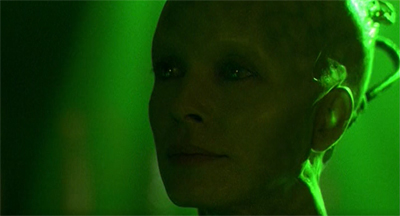
She’s not herself, lately.
Dark Frontier, Part I and Dark Frontier, Part II is forced to recast the role, replacing Alice Krige with Susanna Thompson. Thompson is normally a reliable performer. She was very effective in Rejoined and Frame of Mind. However, she never manages to exude quite the same creepiness that defined Alice Krige’s turn in the role. As played by Alice Krige, the Borg Queen was a kinky escapee from some forgotten nineteenth century gothic horror that had clothed herself in the trappings of cyberpunk. As played by Susanna Thompson, the Borg Queen is just another baddie.
To be fair, Dark Frontier, Part I and Dark Frontier, Part II tries to carry over some of the more interesting aspects of the Borg Queen from First Contact. Most notably, the Borg Queen is presented as a Luciferian influence, whispering dark promises into Seven’s ear as she tries to purchase back the soul of the one that got away. “We’ve come to make you an offer,” the Borg Queen coos into Seven’s cortical implant in Dark Frontier, Part I. “Rejoin the Collective and we’ll spare Voyager.” Seven inquires, “Why me?” The Queen responds, “Because you are unique.”

Seventh heaven.
The Borg Queen’s primary concern over the course of Dark Frontier, Part I and Dark Frontier, Part II is corrupting Seven of Nine. Everything else is secondary. Of course, the Queen argues that this is part of some grand plan to assimilate mankind, but this is somewhat misleading. A single Borg Cube manages to break into Earth’s orbit in both The Best of Both Worlds, Part II and First Contact. All the Queen needs to do is send two or three ships and she should be able to finish the job. More to the point, the Queen is already working on a more subtle assimilation plan.
Indeed, the Borg Queen quite openly lies to Seven about her motives and her objectives repeatedly over the course of the two-parter. Discussing Seven of Nine’s experiences on Voyager, the Queen muses, “We put you there in the first place. You believe that Voyager liberated you from the Collective. Did you really think we would surrender you so easily?” Of course, this theory seems debunked by the fact that the Queen allows Janeway to recover Seven at the end of Dark Frontier, Part II and the fact that Voyager does not spend the next two-and-a-half seasons avoiding the Collective.
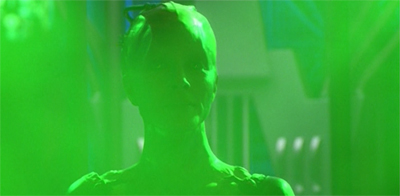
Glowing.
Instead, the Queen’s primary purpose seems to be to corrupt Seven, in the same way that her primary purpose was to seduce Data. Of course, First Contact does a much better job providing a plot-driven motivation of the Queen’s attempt to corrupt Data, but it is clear that Dark Frontier, Part I and Dark Frontier, Part II continue to see the Borg Queen as a dark temptress. The Queen seems to want to make Seven complicit in the atrocities committed by the Borg. In Dark Frontier, Part II, she has Seven oversee the assimilation of an entire species and plot to assimilate mankind.
Of course, Dark Frontier, Part II never quite explains why Seven would allow herself to be even passively complicit in all of this. At one point, enemy ships attack the Queen’s ship. The Queen waits patiently for Seven to figure out an adaptation to protect the ship, which will effectively allow the Borg to wipe out an entire species. That is a horrific choice, forcing Seven to choose between protecting herself and destroying an entire civilisation.
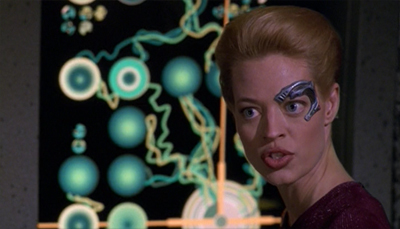
Resistance isn’t even worth attempting, apparently.
However, Dark Frontier, Part II never allows Seven to process the enormity of that choice. As the aliens attack, the Queen asks, “How do you propose we adapt?” Seven is defiant. “You are the Borg. You tell me.” The Queen provides the necessary exposition. “Thirty nine of their vessels are converging on our position. They’re firing weapons. Our shields are failing. We will be destroyed. How do you propose we adapt?” This should be a big moment for Seven of Nine.
After everything that Seven has been through, would she sacrifice her life to save an alien civilisation? Would she die as an individual rather than lose that part of herself? This should be a huge moment for Seven. Instead, Seven caves instantly, “Triaxillate our shield geometry to absorb their phaser pulses.” The Borg Queen acknowledges that she “was thinking the same thing”, but it still feels like Seven never makes a stand. Instead of being a powerless observer, she is an active participant in genocide. The episode settles for Seven rescuing a few stragglers later on.
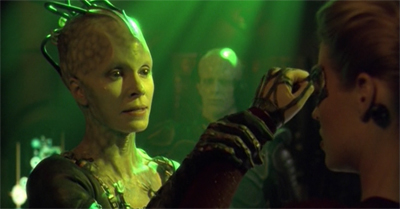
Raising arms against her Queen.
To be fair, the Queen is not interested in this process of assimilation. In fact, given that she has not actively pursued Voyager and only made two attacks on the Federation within the past decade, it seems like the Queen is not particularly interested in the assimilation of mankind. Instead, the Queen seems to pitch the potential assimilation of mankind as advanced therapy for Seven of Nine. “All of your emotions, grief, guilt, remorse, compassion, will be irrelevant once humanity is assimilated,” she helpfully offers.
Susanna Thompson is decidedly less hypersexual in the role than Alice Krige had been. This is in part down to Thompson’s performance, and in part down to the script. It seems highly unlikely that Rick Berman would have allowed the Borg Queen to tie Seven of Nine down to a table and blow softly on her skin. Then again, Voyager had never been particularly shy about hypersexualising Seven of Nine, as demonstrated by her costuming and episodes like Revulsion.

“For some reason, humans always wear sensor-proof jocks. It’s one of the universe’s great mysteries.”
Nevertheless, there are points at which the Borg Queen’s relationship with Seven takes on an air of kink, reflecting Brannon’s recurring fascination with dominance and submission, seduction and corruption. The Borg Queen is clearly trying to dominate Seven of Nine, to bend her to her will. It is similar to the way in which scripts like Cold Fire or Darkling handled Kes, presenting an innocent young woman who seems on the cusp of a pseudo-sexual awakening tied to a sinister and perverse outside force.
The dynamic between Seven of Nine and the Borg Queen is coded in terms of non-consensual sex. While blackmailing Seven to participate in the assimilation of an entire species, she urges, “Stop resisting. Take pleasure in this.” When Seven eventually refuses to give herself over to the Borg Collective, the Queen decides to take her by force. When the Queen instructs Seven to “interface with the central alcove”, Seven declines. “Comply, or we will turn you into a drone,” the Queen threatens. Drones surround Seven. The threat is implied.
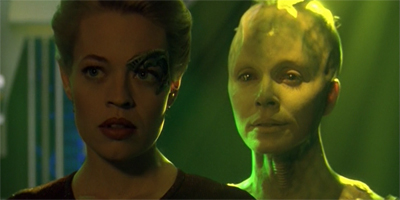
“Feel the power of the dark side.”
While this fits with the long-standing metaphor of assimilation as a sexual trauma, explored in stories like Family, it also feels very crass and exploitative. It is very much in keeping with some of Braga’s long-standing publicly-stated kinks, and continues the producer’s recurring fascination with turning Voyager into a trashy exploitation movie. (This impulse is more benignly reflected in episodes like Phage or Threshold or Macrocosm.) Nevertheless, it is clear that Braga continues to see the Borg Queen as a fundamentally sexual creature.
As such, Dark Frontier, Part I and Dark Frontier, Part II do not introduce the Borg Queen as an addition to the larger Borg mythology. Instead, the two-parter positions the Borg as a faceless army designed to support the Borg Queen. The Borg Collective is no longer the antagonist here, they are little more than muscle acting in service of the Borg Queen and her own corrupting agenda. The big issue with all of this is that the Borg Queen is fundamentally less interesting than the Borg Collective, which makes this transition feel like a downgrade.
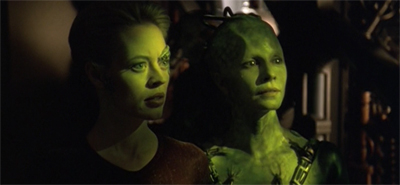
Mommy made of metal.
There is somethign of a conceptual conflict at work here. The Borg Collective have been effectively established as zombies in the traditional movie sense; they are slow-moving, unthinking and unstoppable. In contrast, the Borg Queen fits the horror archetype more associated with vampires. As Justin Everett argues in An Uncanny Reflection:
The Borg Queen, whose undead flesh is little more than that of an animated corpse, demonstrates Dracula-type qualities. Like the Count, who belongs to the former aristocracy (ie, a form of authority long discarded), she too is an aristocrat infesting a modern, science-driven world, and as such, represents at once a long-forgotten past and the very real threat of a future in which humans could be hunted into extinction by drones who are at once insect-like and vampiric. She is a Dracula-type character not only in her corpse-like pallor, her “royal” status, or her ability to create other Borg through blood infection by introducing nanoprobes with the use of fang-like appendages, nor through her sole endeavour to acquire (ie, assimilate) property (ie, worlds) to which she is a foreigner, but through her role as a sensuous devourer.
The very topography of the Queen’s body is a commingling of irreconcilable opposites: she is beautiful, yet fetid; womanly, yet mechanical; alluring, yet terrifying. Unlike the Borg Queen’s emotionless drones, her facial expressions are passionately human and convey her underlying thirst for assimilation in the same way that the sensuous vampire desires the blood (and sex) of his victim. Yet her pallor is whitely mottled like a corpse, and her head sprouts loops of cable, which reminds the viewer that her mind is synonymous with the Collective. When Data asks if she is the leader of the Borg, she replies, “I am the Borg.” The rest of her body, which the viewer knows to be no more than a mechanical extension of her head, is feminine and lithe, engaging the viewer in an irreconcilable play of attraction and repulsion. Unlike the drones, who are horrors of machination, the Borg Queen’s physique, and the sensuality of her movements as she brings Data ever closer to desiring assimilation, is a twin topography of horror and desire.
First Contact was able to work around this disconnect between the Queen and the Collective by largely isolating the Borg Queen in engineering with Data while Picard tried to retake the ship, only bringing them together at the climax. Dark Frontier, Part I and Dark Frontier, Part II have no such protections. The Queen is very much the plot.

Getting it in the neck.
This shift away from the zombie-like Borg Collective to the vampire-like Borg Queen feels very much like a miscalculation on the part of the production team, Brannon Braga moving the concept of the Borg out of step with popular culture. Vampires were arguably something of a spent force in the late nineties and into the early new millennium. There were any number of vampire movies, but never quite a cinematic movement; John Carpenter’s Vampires, Wes Craven’s Dracula 2000, E. Elias Merhige’s Shadow of the Vampire. Even the Blade trilogy was under the radar.
In contrast, zombies were on the verge of breaking out into the popular consciousness. The early twenty-first century would be saturated by zombie horror movies; 28 Days Later, Dawn of the Dead, Shaun of the Dead, Land of the Dead, Planet Terror, [rec], I Am Legend, Resident Evil, Zombieland, and so on. In contrast, Twilight would be the most successful twenty-first century vampire franchise. Given the way that fandom in general recoiled from Twilight, it seems unlikely that Star Trek fans wanted that type of story built around the Borg.

“I have you now, my pretty.”
While Braga had no way of knowing that a zombie movie explosion was around the corner, it still feels like a major miscalculation to suddenly retool the Borg from a horde of zombies to a nest of vampires with a Queen. It feels like a major misunderstanding of how the Borg became a breakout alien threat on The Next Generation, reworking into something much more derivative and much more confused. While the Borg Queen is clearly a Luciferian or vampiric figure, even her role within the Collective remains hazy and ambiguous in a way that seems more lazy than knowing.
This interest in individuality trickles down from the Borg Queen to the portrayal of the drones themselves. Episodes like The Best of Both Worlds, Part I, The Best of Both Worlds, Part II, Scorpion, Part I and Scorpion, Part II suggested that a Borg ship worked like a single entity. Picard and Janeway could speak into chasms in the centre of the ship and hear thousands of voices responding as one. In contrast, even before it introduces the Borg Queen, Dark Frontier, Part I opens with a teaser told from the perspective of an individual drone.

“Coffee first. Rescue later.”
This is a clever idea on paper. What does space travel look like from the perspective of the Borg Collective? How do ships full of drones process information and reach decisions? Do the individual drones operate like cells in a larger organism? There is something intriguing in that very premise, an encounter between Voyager and Borg ship that invites the audience to put themselves alongside the Borg Collective in opposition to the credited leads.
Unfortunately, the execution is disappointingly conventional. The teaser to Dark Frontier, Part I is told from the perspective of a Borg drone, but structured in an incredibly patronising way. The scene features the drone walking to a display that will show Voyager and allow Janeway to address the Borg ship. Despite the fact that the drone is connected to the ship itself, the drone still watches the obligatory “stand-off” conversation with Janeway on a conveniently-placed monitor. This confrontation with the Borg is the same as any other Delta Quadrant encounter.

Monitoring the situation.
Dark Frontier, Part I and Dark Frontier, Part II effectively rip out a lot of the mystery and intrigue around the Borg. Not only does the two-parter offer a frustratingly pedestrian perspective on life inside the hive mind, it also retroactively reveals that the Borg were apparently never that mysterious or ambiguous. The Hansen family chased the Borg for quite some time, and came to understand the complex inner workings of this most alien of species long before Picard was forced to flee in terror in Q Who?
Even Magnus Hansen knows about the Borg Queen, in a transparent attempt to graft the character into the back story of the Borg. Of course the Borg Queen is a valid piece of continuity, the episode seems to suggest, even the Hansens knew about her before Picard got thrown into the Delta Quadrant, so stop whining about how this fits in with the canon. It is clumsy. “We think he used to work near the Borg Queen,” Magnus reports of a recently tagged drone. “I want to read through his cranial transceiver logs, see if he was ever in direct contact with the Queen.”
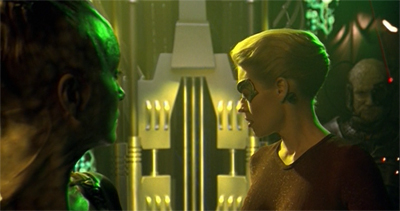
“It really ties the room together.”
At the same time, there is something very banal about the Borg Queen as featured in Dark Frontier, Part I and Dark Frontier, Part II, as if the character is even more of a conventional antagonist than she was in First Contact. As Magnus studies his drone, Annika asks, “Does the Queen have a throne?” Magnus shrugs, “Nobody knows.” Of course, the Borg Queen probably shouldn’t have a throne, seen as she is an alien representative of a bunch of cybernetic zombies. However, the “central alcove” serves the same purpose as Chaotica’s throne in Bride of Chaotica!
The Borg Queen becomes just a generic bad guy. “We all originated from lesser species,” she assures Seven at one point. “I myself came from species one two five. But that’s irrelevant now.” While it’s not a detailed origin, it does seem fairly standard. The Queen spouts familiar Borg catchphrases. “In this case, our thoughts are not one,” she observes wryly at one point. She knows Janeway by name, spitting the name like a pantomime villain when Seven reestablishes contact. The Queen is driven by self-preservation, backing her drones off when Janeway threatens her.
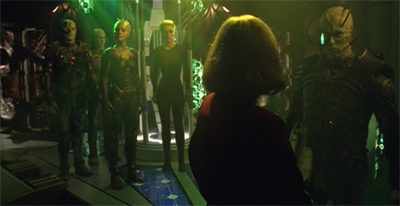
Women at war.
At points, the Borg Queen doesn’t even feel like a stock bad guy archetype. There are moments when the Borg Queen feels almost like supervillain middle-management, dolling out tasks and checking boxes inside a gigantic evil organisation. She gets Seven to prepare a report on the “tactical weakness” and “tactical strength” of her target species, which Seven does for some reason. When that assimilation is complete, she directs Seven, “You can assist with the repairs to our shield matrix instead. Seven of Nine. Be efficient.”
Nevertheless, there is some potentially interesting buried beneath all of this. Dark Frontier, Part I and Dark Frontier, Part II seem very cynical and subversive when it comes to ideas like family. In particular, both the Borg Queen and Janeway are presented as warped grotesque surrogate mothers to Seven of Nine, women who claim to represent ideals of family and belonging but who also yearn to control and dominate Seven.

“Time to review the Borg Chart, eh?”
In Dark Frontier, Part I, Janeway effectively forces Seven to read the log entries made by her parents, despite Seven’s hesitation. Much like the Queen seems more interested in forcing Seven to become complicit in the process of assimilation than in the process of assimilation itself, Janeway seems particularly interested in making Seven read those logs. “Look, these records have been collecting dust in our database for over a year. You say they’re irrelevant, and I say you’ve been avoiding them.”
Janeway acknowledges any other member of the crew could read them, even namedropping “Chakotay” because he has very little to do in this two-parter. Janeway is also aware of the fact that Seven does not want to read these log entries. As such, it seems like Janeway is particularly interest in having Seven read those log entries and re-live her childhood trauma. In some ways, it seems as though she is just trying to assert dominance over Seven in the same way that the Borg Queen does.
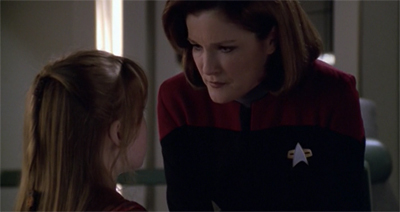
It’s Wild(man) out there.
As David Greven points out in Gender and Sexuality in Star Trek, this skepticism of parental figures bleeds through into the extended flashback sequences:
This ambivalence towards family deepens into an almost open declaration of contempt in its depiction of Seven’s biological parents, the Hansens. The human Seven was born Annika Hansen; her parents Magnus and Erin Hansen were scientists who boldly studied the Borg, the first to do so up close. They would surreptitiously beam into a Borg cube to observe their culture (Borg anthropology studies). But they also recklessly brought along the young Annika on this scinetific mission, during which the entire family was assimilated.
Magnus and Erin Hansen are spectacularly terrible parents, who made horrible decisions that subjected their daughter to untold trauma. However, the two-parter seems to concede this.
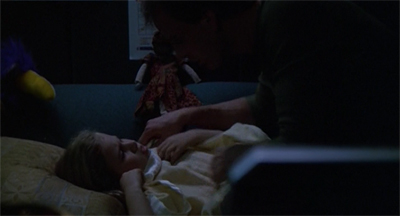
“Don’t worry, I’m sure you’ll get to make plenty of friends fairly soon.”
Seven talks about her parents in a way that seems openly contemptuous. In Dark Frontier, Part I, Seven rejects the hero narrative that other characters try to build around the Hansens. “They must have been very courageous,” Neelix observes. Seven coldly responds, “They were misguided.” Janeway is impressed by their work. “I want you to study their research,” she tells Seven. “Look for any data that might give us a tactical edge.” Seven dismisses the suggestion. “My parents were assimilated. Obviously their tactics were flawed.”
The EMH tries to suggest that this experience will help Seven “build character”, that she has an obligation to learn of and respect her family history. “This is an important stage of your social development, Seven,” the EMH states. “Try not to think of it as simply a research project, but as an exploration of how you were raised.” Seven responds, quite succinctly. “My parents underestimated the Collective. They were destroyed. Because of their arrogance, I was raised by Borg.” The episode seems to support her position.
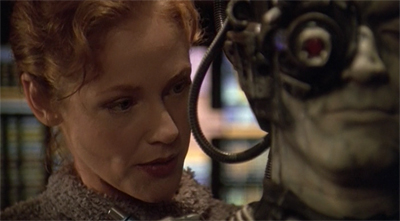
Erin her problems.
Genre storytelling tends to glamourise such reckless parenting, focusing on characters who throw their entire families into danger in the pursuit of adventure or scientific process; the Robinson family in Lost in Space, Reed Richards and his family in Fantastic Four #1, even the families on the Enterprise over the course of The Next Generation. As such, the contempt that Dark Frontier, Part I and Dark Frontier, Part II demonstrate for the Hansen family is refreshing, a slight subversion of a long-standing genre trope that goes unquestioned far too often.
Even more interesting is the faint suggestion that Seven has not actually found a family on Voyager itself. The Borg Queen tries to chip away at Seven’s sense of identity and belonging by arguing that she never belonged with the crew. “Forget Voyager. They were never your Collective.” It is very much a stock seductive supervillain argument, an attempt to corrupt the weakest member of the opposition team into betraying their friends and family. However, in their smartest moments, Dark Frontier, Part I and Dark Frontier, Part II suggest there is some truth to it.

All the best drones have daddy issues.
Early in Dark Frontier, Part I, after Voyager has destroyed the scouting Borg ship, Seven walks in on a conversation between Paris and Kim about the attack. “To be honest, I wish the boom had been a bit smaller,” Kim confesses. “We were only trying to disable them.” Paris shrugs it off. “They were drones, Harry,” he explains. “Mindless automatons. We did them a favour.” It is an interesting scene, if only because it demonstrates the way that the crew of Voyager think about the Borg Collective, and how alienating that must feel to Seven of Nine.
Early in the fourth season, there were some hints of tension between Seven and the rest of the crew. In The Gift, Chakotay softly broaches the possibility that bringing Seven of Nine into the fold might not be possible. In Day of Honour, Torres is resistant to working with Seven of Nine. However, these tensions never really amount to anything. Chakotay never really makes a point of stressing how difficult integrating Seven into the crew might be, even after missteps like Retrospect or Prey. Torres is by default confrontational, a trait established as early as Parallax.

“Why, oh why couldn’t the Borg have captured Harry Kim?”
Seven never has to confront a member of the crew who actively and legitimately has a problem with her. Janeway works hard to allow her to develop, even building a specialised astrometrics laboratory for her. Kim works hard to make her feel like part of the crew in Revulsion. Paris assures her that he is sympathetic to her plight in Day of Honour. Even Tuvok reassures her of her importance in Hunters. Seven never comes face to face with a survivor of (or someone who lost a family member at) Wolf 359, who would harbour an understandable resentment of the Collective.
Even within Dark Frontier, Part I and Dark Frontier, Part II, this idea that Seven has not been fully integrated into the crew is never fully explored. The conversation between Kim and Paris in the messhall is just about the only indication that Seven might not feel welcome on the ship, and it is counteracted almost immediately by a short scene with Naomi Wildman. As a result, the Borg Queen’s attempts to undermine that relationship between Seven and the crew feels shallow and superficial, the outline of a narrative beat rather than a fully-drawn character arc.

“Can we keep him?”
Nevertheless, there is an interesting kernel in this suggestion that Voyager is not the idealised family that it might appear to be. The Borg always worked well as a counterpoint to the primary cast of The Next Generation, a collective where any shred of individuality had been removed or destroyed. In contrast, the crew of the Enterprise had always been a collective built on diversity; a wide range of characters with a wide range of personalities using their unique perspectives to solve complex problems. The Borg were a pointed inversion of that.
Voyager never quite developed its cast to that extent. Five seasons into the show, almost half the cast are still blank slates; Chakotay, Kim, Tuvok. Even Paris doesn’t really have a consistent characterisation, as episodes like Vis à Vis suggest. Janeway has been no less than three different characters over the course of the show. Even the underdeveloped characters on The Next Generation, like LaForge or Troi, seem like fully-formed individuals when compared to most of the cast on Voyager.

Does she want to return to the Collective? Nien.
In some ways, the repurposing of the Borg Collective Dark Frontier, Part I and Dark Frontier, Part II fashions the Collective into a twisted mirror of Voyager. The Borg Collective becomes a matriarchy led by a strong female with a forceful personality and an obsession with Seven of Nine. In some ways, the crew of Voyager is something similar; Janeway is a strong and decisive leader surrounded by a fairly bland set of characters, but who has a single-minded fascination with sculpting Seven of Nine in her image.
Perhaps some of the flaws with Borg Collective in Voyager are just a reflection of the flaws within Voyager itself.
Filed under: Voyager | Tagged: borg, borg queen, dark frontier, family, motherhood, star trek, star trek: voyager, the borg, vampires, zombies |




















I’ve not visited all of Voyager since it first aired, so this comment is based on your thoughts and my faded memories. I feel like one of the bigger mistakes modern Trek made with the Borg was giving them to us time and again, whenever it felt like interest in the franchise was waning. In many ways, they began to feel like the Daleks on Doctor Who in that you could trot them out and guarantee a spike in press coverage. Whether this translated into stronger ratings, I don’t recall.
But the more we saw the Borg, the less mysterious and interesting they became. With their appearances on TNG up to “Descent, Part 1,” there was an air of mystery and unstoppability about them. Once we get into Voyager, it felt like the production team wanted to bring them back but you can’t have the Borg hammer Voyager out there all alone for an episode or two. So they were de-fanged a bit. And we go to know one as a member of our crew. All well and good, I suppose. But it really felt the magic and allure and the palpable sense of dread and discomfort that “Q Who?” and “Best of Both Worlds, Part One” had vanished. (I defy you to find a better, creepy moment in Trek than when the Enterprise D crosses paths with the Borg cube to end an act in BoBW, Part 1.)
The Borg got some of their moxy back in First Contact (movie) but quickly lost it when Voyager started jumping into the Borg well one too many times. I feel like Braga missed the point of why fans loved First Contact. It didn’t reset the Borg back to that sense of dread from early TNG episodes. But they got their mojo back. Only to see Braga drain it all again.
That moment in Best of Both Worlds is amazing. It’s one of the rare times in the Berman era that we hear a chorus, if I remember correctly? I might be wrong.
Lol, I bet that’s how they pitched it to Rick. “It’ll be like Ben-hur.””
Then it backfired with Enterprise. Rick: “It’ll be just like the Best of Both Worlds.”
You mean like the Daleks who went from dynamic figures to bland muscle once an over the top, more humanoid leader was created for them?
Nah, the Borg are nothing like that 😉
Darren backs slowly away, keeping his love of Revelation of the Daleks and Remembrance of the Daleks to himself.
I love those stories too, but as a trend, that is what happened.
I know, I know. I was more being a little cheeky. 🙂
What stings is that TNG seemed to have turned a corner with the Borg. They were dogmatic aliens who couldn’t be lectured to by Picard and their ships honestly would have made mincemeat of Kirk’s Enterprise. It was uncharted territory and it was very thrilling.
Over time they became indistinct from the other species on Star Trek, all of whom suffered from overexposure to some degree.
But what really galls is that the Borg fell into the familiar Star Trek trap: contradicting their own philosophy.
Borg need a Queen to preach about the virtue of collectivism. Klingons talk big, but they’ll steal the shirt off your back. The Vulcans rescued Earth from poverty and disease, and they became bipolar maniacs. (And don’t give me manure about the Vulcans being villains from the start. They were treated with shades of gray, like most other races on TOS.)
I don’t mind the Klingons being exposed as hypocritical and contradictory. Most societies tend to have a gap between self-image and reality, and I think that the Klingons cover that very well.
But, yeah, there’s no excuse for the Borg behaving in that way.
>”The Borg have never”
This probably goes without saying, and I agree with the thrust of your argument. But the “Scorpion” two-parter is an effective substitute. The Borg did have the run of the cargo bay after that, with Seven almost subduing the bridge crew at one point, and it would have hurt their image to get booted out the ship with as much ease as the Kazon. It also fits with TNG/First Contact’s depiction of the Borg. They won’t harm anyone they don’t consider a threat, but this means their motives are only partially revealed, and they’re still dangerous.
It’s a nice inversion of a well worn trope, which we were reminded of in “Prophecy” when Klingons tried to take over.
I know I’ve said it before but I honestly think you are too hard on ‘Voyager’ and not nearly hard enough on ‘The Next Generation’ when it comes to the Borg.
I mean ‘I, Borg’ treated the idea that the Federation could completely collapse the Collective entirely seriously and ‘Descent, Part I’ and ‘Descent, Part II’ actually show the Collective in ruins – I know this was later retconned by ‘First Contact’ (which more or less reset the Borg back to their ‘Best of Both Worlds’ status) but ‘Descent’ really does seem to suggest the Borg as a whole have imploded.
In fact fully half the Borg stories from TNG have the Borg severely humbled. This isn’t neccessarily a bad thing – ‘I, Borg’ is one of my favourite TNG episodes – but ‘Voyager’ did not begin the decline.
I can’t speak for darren, but it doesn’t bother me that the Borg are humbled, as you wrote. More that its the frequency with which they are defeated, with each victory being more definitive than the last.
Hugh’s rebellion worked because we had already seen the borg get defeated and it was a facet to them we hadn’the seen before. They were even reduced to the role of victims under Lore’s regime. If borg aren’t to be feared any more than there is really no reason for them to be the over arching bad guy in later episodes, other than to jazz the audience, which is counter intuitive since they pose no threat.
By the time endgame rolls along, you’re just kind of sitting there rolling your eyes at the ease with which janeway is blowing up cubes with a single shot and reinfecting the queen with the icheb virus. Not only does the collective die along with the queen a la first contact, but the entire unimatrix blows up.
The Hierarchy Posed a bigger threat in season 7 and that is saying something.
That might be some of my frustration as well. It’s the sense that the Borg are supposed to be both an unstoppable force and the kind of threat that Janeway encounters off-screen and deals with in teasers.
That’s probably fair. But I still think that TNG treated the Borg as a credible threat. When they find the wreckage of the Borg cube in I, Borg, it’s a huge deal. When the Borg reappear in Descent, it’s so big a deal that Nechayev shows up to chew out Picard. Voyager tends to treat Borg attacks like they happen every other week and are no biggie. Indeed, Dark Frontier, Part I seems to imply that Janeway has had a number of off-screen encounters with them. The Borg should be such a big deal that there are no off-screen encounters, and Voyager isn’t casually blowing up ships in the teaser to the two-parter.
There is a kernel of a good idea in the Borg Queen. To me, one of the problems is that this is meant to be the same Borg Queen from First Contact through to the end of Voyager.
Having a single figure to communicate isn’t a bad idea.
Even in “Best of Both Worlds”, the Borg made Locutus to talk to the Enterprise.
Have The Borg Queen not be a queen, but rather something the collective manifests as something it needs for that situation. It’s not a character, it is the collective manifesting itself.
Best of Both Worlds: They use Picard to unsettle Starfleet, but he’s not fully converted so he can fight back
First Contact: Through Picard, they know Data’s goals, and produce a seductress to tempt him since brute force won’t work
Here, there should have been something different. Maybe start with a First Contact style one, who gets killed within 5 minutes, and without missing a beat, a new queen/king emerges/is created on screen with traits based on what they think will help defeat Voyager.
You’re on to something there; First Contact is very cleverly written to indicate that the Queen is a sort-of incarnation of the collective, and not a leader-figure. An avatar, really; “I am the one who is many” sounds almost religious and still keeps the idea alive that the Borg are beyond human understanding. While obviously the Queen was introduced for dramatic purposes, Ronald Moore acknowledged that the Borg Queen was a contradiction and worked to justify the character
The team of Braga and Menosky didn’t really seem to get that. They just took a cool-looking antagonist and put it in their show. That’s fine for their purposes, but not very satisfying.
Being honest, I think the Queen in First Contact is maybe a lot less justified than the one in Voyager, but that’s one of the reasons that she works so well. Voyager over-explains her; she came from species one-hundred-and-something, she is a more conventional leader, she behaves a lot more like a conventional Star Trek baddie. Whereas First Contact just lets her exist while understanding the inherent contractions; no idea where she came from, no idea what exactly she does, making a conscious effort to swat away the sort of easy answers that Voyager would unironically embrace.
Maybe. I mean, I think you’re right that the big issue with Dark Frontier is that it tries to copy First Contact beat-for-beat without question, substituting Seven of Nine in for Data. But I’m not sure that the Queen is salvageable without a radical overhaul of the kind that Voyager was never going to give her.
This episode disturbed me when it first aired, mainly for the scenes with the alien race being assimilated. The screams of torture and sorrow in the background, and the amputees… In some ways it goes beyond First Contact because it’s implied that families are being torn asunder, children and mothers assimilated in front of each other, etc. Voyager never lets you get that close to the reality of what they’re depicting, but it still was quite dark. Seven is never really held to account for the things she’s done.
I also find it odd she didn’t rescue her own father, when she had a clear opportunity to do so. The Borg queen’s ship is destroyed…along with Seven’s dad we assume. She doesn’t even care. It’s a serious oversight.
You’re right about Braga not really understanding what the Borg were. As Q says in Q Who?:
“The Borg are the ultimate user. They’re unlike any threat your Federation has ever faced. They’re not interested in political conquest, wealth, or power as you know it. They’re simply interested in your ship, its technology. They’ve identified it as something they can consume.”
This paints the Borg as techno-capitalists in a sense, channeling the works of Jacques Ellul in his book “The Technological Society”. The addition of the Queen totally counters all of their supposed ethos. They are rendered a feudal society of serfs. Their sheer lack of personality was what made them so unique as Trek villains. Braga is often credited with ‘high concept’ writing (whatever that means), but there is a distinct lack of interesting human society and relationships in his works. He likes sex, time travel, memory, and action for action’s sake.
Ah well. It is still a fun spectacle of a show at times. This episode has a lot going on for it in terms of motherhood, with Seven-Janeway-BorgQueen-Naomi acting as a sort of connected series of maternal metaphors. Strangely, Sevens biological mother is extremely abstract as a character. We barely get any sense of her personality or background.